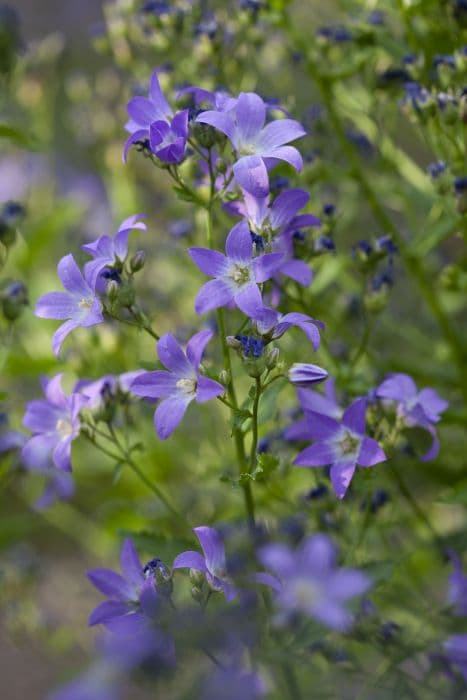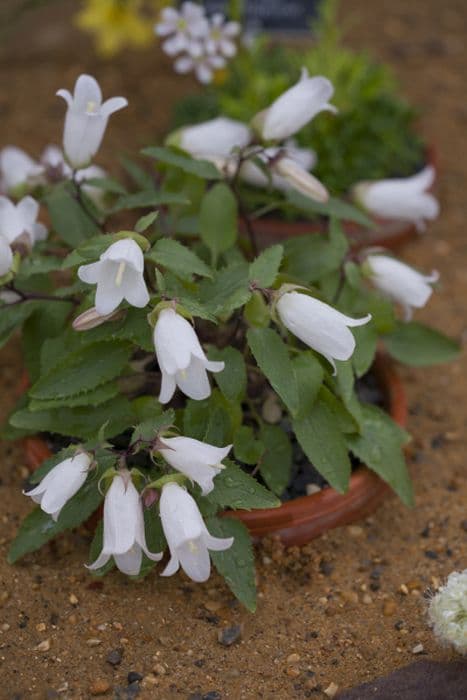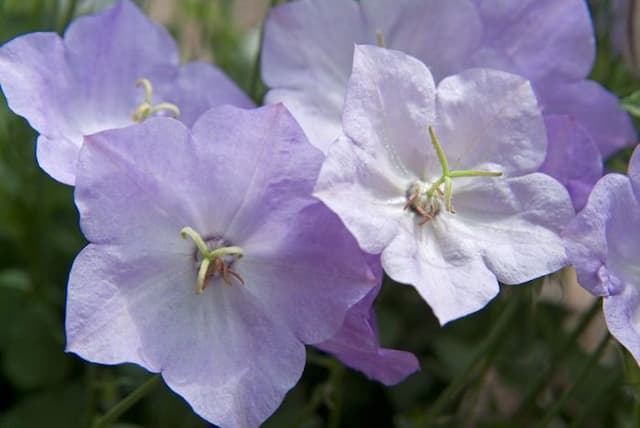Milky Bellflower Campanula lactiflora 'Favourite'

ABOUT
The Campanula lactiflora 'Favorite', commonly known as the Milky Bellflower 'Favorite', is a perennial plant that features an attractive, bushy habit. Its stems bear large, lance-shaped leaves that are deep green, providing a lush backdrop for the blooms. Throughout the flowering season, the plant is adorned with clusters of bell-shaped flowers. These flowers exhibit a charming blue-violet color with a soft, romantic hue that can add a touch of whimsy to any garden. The blooms are poised on the top of tall, upright stems, densely packed into rounded clusters that create a delightful visual impact. Each individual flower is a small and dainty bell, with the petals slightly opening at the mouth, revealing the white to light lavender inner throat. The overall appearance of the Milky Bellflower 'Favorite' is one of elegance and simplicity, making it a beloved addition to garden borders, cottage gardens, or as a cut flower in floral arrangements. The flowers attract bees and butterflies, adding to the dynamic ecosystem of a garden.
About this plant
 Names
NamesFamily
Campanulaceae
Synonyms
Milky Bellflower, Caucasian Bellflower
Common names
Campanula lactiflora.
 Toxicity
ToxicityTo humans
Milky Bellflower is not known to be toxic to humans. There are no common symptoms of poisoning associated with this plant because it is not generally considered poisonous. Therefore, ingesting parts of the Milky Bellflower should not lead to any toxic consequences for humans.
To pets
Milky Bellflower is also not known to be toxic to pets. It is not typically listed as a poisonous plant for animals like cats and dogs. Consequently, the ingestion of any parts of the Milky Bellflower by pets is not expected to result in poisoning or produce harmful symptoms.
 Characteristics
CharacteristicsLife cycle
Perennials
Foliage type
Deciduous
Color of leaves
Green
Flower color
Blue
Height
4 feet (1.2 meters)
Spread
2 feet (0.6 meters)
Plant type
Herb
Hardiness zones
5
Native area
Caucasus
Benefits
 General Benefits
General Benefits- Aesthetic Appeal: Adds vivid blue or white bell-shaped flowers to gardens, enhancing visual interest.
- Attracts Pollinators: Invites bees, butterflies, and other beneficial insects that support pollination.
- Easy to Grow: Adaptable and hardy, tolerating a wide range of soil types and climates.
- Low Maintenance: Requires minimal care beyond basic watering and occasional feeding.
- Long Blooming Period: Provides a long season of blooms, typically from late spring to early fall.
- Deer Resistance: Less likely to be eaten by deer compared to other garden plants.
- Cottage Garden Style: Ideal for creating a classic cottage garden look with its informal appearance.
- Border Planting: Suitable for planting along borders due to its upright habit and clumping growth.
- Height Variety: Comes in various sizes, making it versatile for different garden settings and designs.
 Medical Properties
Medical PropertiesThis plant is not used for medical purposes.
 Air-purifying Qualities
Air-purifying QualitiesThis plant is not specifically known for air purifying qualities.
 Other Uses
Other Uses- Photography Prop: Campanula lactiflora, commonly known as the Milky Bellflower, can serve as an elegant backdrop or subject for botanical photographers looking for delicate textures and colors.
- Artistic Inspiration: Artists may use the intricate details and form of the Milky Bellflower as inspiration for paintings, drawings, or sculptures.
- Educational Tool: Biology educators can showcase the Milky Bellflower to discuss pollination and plant growth habit in gardening classes or workshops.
- Craft Material: Dry or pressed flowers of the Milky Bellflower can be used in scrapbooking, card making, or other paper crafts for a natural touch.
- Environment Enrichment for Insects: The Milky Bellflower can be planted to enrich the habitat for beneficial garden insects like bees and butterflies beyond traditional garden use.
- Fabric Dye: The petals of the Milky Bellflower could potentially be used to create a natural dye for fabrics, offering a range of soft blue and lilac hues.
- Culinary Decoration: Edible varieties of the flowers can be used to embellish cakes and desserts, provided they are free from pesticides and other chemicals.
- Garden Themed Events: The flowers can provide a thematic element for garden parties and other events, contributing to decorations or table settings.
- Botanical Illustration: The Milky Bellflower is an excellent subject for botanical illustration classes, where students can learn to capture the intricate structures of plants.
- Perfume Inspiration: Though not a common use, the Milky Bellflower's subtle fragrance can inspire natural perfume makers in crafting unique floral scents.
Interesting Facts
 Feng Shui
Feng ShuiThe Milky Bellflower is not used in Feng Shui practice.
 Zodiac Sign Compitability
Zodiac Sign CompitabilityThe Milky Bellflower is not used in astrology practice.
 Plant Symbolism
Plant Symbolism- Gratitude: The bell-shaped flowers of the Campanula, commonly known as Bellflower, are often associated with gratitude, likely because they resemble small bells, which historically have been used to call people together to express thanks.
- Constancy and Perseverance: Bellflowers return year after year, symbolizing constancy and the perseverance to endure and thrive in a variety of conditions.
- Humility: The way the Bellflower's blooms hang down in a humble position suggests modesty and a down-to-earth nature, embodying the virtue of humility.
- Unwavering Love: With its endless blossoms, the Bellflower suggests the theme of unchanging and everlasting love, making it a perfect token for expressing enduring affection.
- Hope: As a perennial that re-emerges each spring, Bellflowers carry the symbolism of hope and the renewal of life, much like many other perennial blooms.
 Water
WaterThe Milky Bellflower should be watered thoroughly once the top inch of soil feels dry to the touch, which typically means once a week, but this can vary depending on environmental conditions. During the growing season, provide it with approximately one gallon of water per week, ensuring you water the base of the plant rather than the foliage to help prevent disease. During the winter or in cooler climates, reduce the watering frequency as the plant requires less moisture. It's important not to let the soil become waterlogged, so ensure good drainage.
 Light
LightThe Milky Bellflower thrives in full sun to partial shade. It prefers a spot that receives at least six hours of sunlight per day, but it can tolerate some afternoon shade, especially in hotter climates. Avoid placing it in deep shade, as this can lead to poor flowering and leggy growth.
 Temperature
TemperatureThe Milky Bellflower can withstand a range of temperatures, surviving minimum temperatures down to around 20 degrees Fahrenheit. However, the ideal temperature range for optimal growth is between 60 and 70 degrees Fahrenheit. It's crucial to protect the plant from harsh winter conditions by applying mulch or bringing it indoors if potted.
 Pruning
PruningPruning the Milky Bellflower is beneficial for maintaining its shape and encouraging new growth. The best time to prune is in late winter or early spring before new growth starts. Remove any dead or damaged stems and cut back the plant by about one-third to one-half to promote bushier growth. Deadheading spent flowers can also encourage a second bloom in the same season.
 Cleaning
CleaningAs needed
 Soil
SoilThe Milky Bellflower prefers a well-draining soil mix rich in organic matter. The best soil mix for this plant would include equal parts of garden loam, peat, and sharp sand to ensure drainage and fertility. The ideal soil pH for Milky Bellflower should be slightly acidic to neutral, ranging from 6.0 to 7.0.
 Repotting
RepottingMilky Bellflowers generally do not require frequent repotting. They should be repotted every 2-3 years or when they outgrow their current container to give the roots enough room to grow and access to fresh soil nutrients.
 Humidity & Misting
Humidity & MistingMilky Bellflower thrives in average to high humidity conditions but is adaptable to most household environments. Aim for a humidity level between 40% to 60% for optimal growth.
 Suitable locations
Suitable locationsIndoor
Place in bright, indirect light and water regularly.
Outdoor
Ensure full sun to partial shade and well-draining soil.
Hardiness zone
3-9 USDA
 Life cycle
Life cycleThe life of the Milky Bellflower 'Favourite' begins with seed germination, typically in spring, when the soil has warmed and moistened sufficiently. The emerging seedlings develop into juvenile plants with a characteristic rosette of basal leaves. As the plants mature, they send up taller stems, which will eventually bear the trademark clusters of bell-shaped flowers, typically in the summer months. After flowering, pollination occurs, leading to the production of seeds contained within the spent flower heads. These seeds can then be dispersed to begin a new cycle or may go through a period of dormancy before germinating the following season. The Milky Bellflower 'Favourite' is a perennial plant, so it will die back to the ground in winter and resprout from its root system the next spring, continuing its life cycle for several years.
 Propogation
PropogationPropogation time
Spring-Early Summer
Propogation: The best time to propagate Campanula lactiflora 'Favourite', commonly known as the Milky Bellflower, is during the spring or early summer. The most popular method of propagation for this plant is by division. You would need to carefully dig up the plant and gently separate the root clumps into smaller sections, ensuring that each new section has a part of the root system. These sections can then be immediately replanted into well-prepared soil, at the same depth they were previously growing. Water them well after planting to help establish the new divisions. It's important that they are placed in an area that provides good drainage and is not prone to waterlogging, as the Milky Bellflower prefers moist but well-draining conditions.









![Milky bellflower [Avalanche]](/_next/image?url=https%3A%2F%2Fplants-admin.emdemapps.com%2Fimages%2Fplants%2F%2Fimages%2F604b5dc88c1e7.png&w=640&q=75)